
Ficus is a genus of about 850 species of woody trees, shrubs, vines, epiphytes and hemiepiphytes in the family Moraceae. Collectively known as fig trees or figs, they are native throughout the tropics with a few species extending into the semi-warm temperate zone. The common fig (F. carica) is a temperate species native to southwest Asia and the Mediterranean region, which has been widely cultivated from ancient times for its fruit, also referred to as figs. The fruit of most other species are also edible though they are usually of only local economic importance or eaten as bushfood. However, they are extremely important food resources for wildlife. Figs are also of considerable cultural importance throughout the tropics, both as objects of worship and for their many practical uses.

A banyan, also spelled "banian", is a fig that begins its life as an epiphyte, i.e. a plant that grows on another plant, when its seed germinates in a crack or crevice of a host tree or edifice. "Banyan" often specifically denotes Ficus benghalensis, which is the national tree of India, though the name has also been generalized to denominate all figs that share a common life cycle and used systematically in taxonomy to denominate the subgenus Urostigma.

Nopal is a common name in Spanish for Opuntia cacti, as well as for its pads.
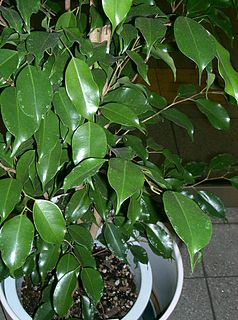
Ficus benjamina, commonly known as weeping fig, benjamin fig or ficus tree, and often sold in stores as just ficus, is a species of flowering plant in the family Moraceae, native to Asia and Australia. It is the official tree of Bangkok. The species is also naturalized in the West Indies and in the states of Florida and Arizona in the United States. In its native range, its small fruit are favored by some birds, such as the superb fruit dove, wompoo fruit dove, pink-spotted fruit dove, ornate fruit dove, orange-bellied fruit dove, Torresian imperial pigeon, and purple-tailed imperial pigeon.
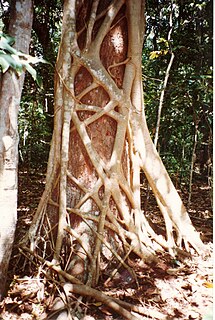
Strangler fig is the common name for a number of tropical and subtropical plant species, including some banyans and unrelated vines, including among many other species:

Pachylia ficus, known as the fig sphinx, is a moth of the family Sphingidae. It lives from the northern tip of South America in Uruguay through Central America to the southern tip of the United States straying into Arizona and Texas.
The General Extension Division (GED) at the University of Florida was created by the state legislature in 1919. The General Extension Division was established as the extramural college to represent all of the state institutions of higher learning except in agriculture, home economics, and engineering. The head of extension was initially designated a director, but was later elevated to dean with the responsibility of making recommendations concerning policies, organization, staff, finance, and the development of the program. Originally, the Dean of General Extension reported solely to the President of the University of Florida, but later was accountable to all of the state's university presidents. GED's first and only dean was Bert C. Riley.

Ficus aurea, commonly known as the Florida strangler fig, golden fig, or higuerón, is a tree in the family Moraceae that is native to the U.S. state of Florida, the northern and western Caribbean, southern Mexico and Central America south to Panama. The specific epithet aurea was applied by English botanist Thomas Nuttall who described the species in 1846.
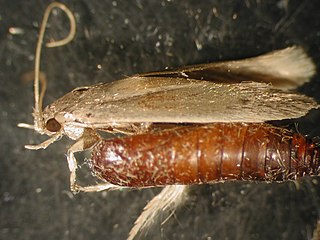
Opogona sacchari, the banana moth, is a moth of the family Tineidae. The species was first described by Wenceslas Bojer in 1856. It is native to the humid tropical and subtropical regions of sub-Saharan Africa, where it is also found in Madagascar, Mauritius, Réunion, Rodrigues Island, the Seychelles and St. Helena. It was first reported from the Canary Islands in the 1920s. In the 1970s, it was introduced into Brazil and Central America, and also appeared in Europe. It has been reported from Florida since 1986.
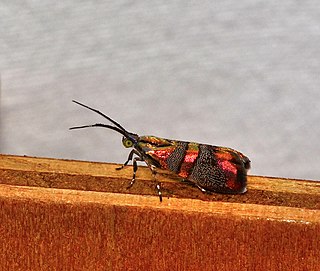
Tortyra slossonia, commonly known as the reflective tortyra moth, ficus budworm or Slosson's metalmark moth, is a moth of the family Choreutidae. It is known from Florida.
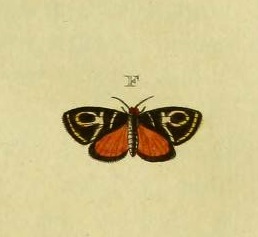
Hemerophila is a genus of moths in the family Choreutidae. A number of species was recently transferred to the genus Ornarantia.

Marpesia eleuchea, the Antillean daggerwing, is a species of butterfly of the family Nymphalidae. It is found in the West Indies. Occasional strays can be found in the Florida Keys.

Ficus hispida also known as the Opposite leaf Fig is a small but well distributed species of tropical fig tree. It is dioecious, with male and female flowers on separate individuals. It occurs in many parts of Asia and as far south east as Australia. There is a large variety of local common names. Like a number of ficus, the leaves are sandpapery to touch. An unusual feature is the figs which hang on long stems.

Lymire edwardsii, the rubber tree caterpillar or Edwards' wasp moth, is a moth of the subfamily Arctiinae. It was described by Augustus Radcliffe Grote in 1881. It is found in southern Florida, United States.

Hemerophila albertiana is a moth in the family Choreutidae. It was described by Pieter Cramer in 1781. It is found in Venezuela, Brazil, Peru and Guyana.
Hemerophila arcigera is a moth in the family Choreutidae. It was described by Cajetan Felder, Rudolf Felder and Alois Friedrich Rogenhofer in 1875. It is found in Brazil.
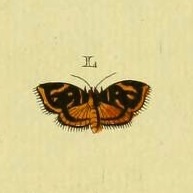
Hemerophila houttuinialis is a moth in the family Choreutidae. It was described by Pieter Cramer in 1782. It is found in Suriname.
Hemerophila milliaria is a moth in the family Choreutidae. It was described by Edward Meyrick in 1922. It is found in Peru.
Hemerophila triacmias is a moth in the family Choreutidae. It was described by Edward Meyrick in 1926. It is found in Colombia.
Hemerophila orinympha is a moth in the family Choreutidae. It was described by Edward Meyrick in 1926. It is found in Peru.













